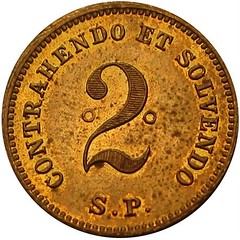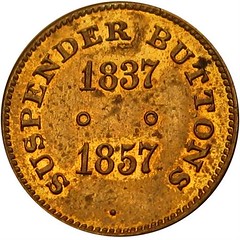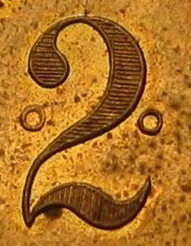
PREV ARTICLE
NEXT ARTICLE
FULL ISSUE
PREV FULL ISSUE
V25 2022 INDEX E-SYLUM ARCHIVE VOCABULARY TERM: LIMITING GUIDEHere's another entry from Dick Johnson's Encyclopedia of Coin and Medal Terminology. I added token images from the website of dealer Steve Hayden. -Editor Limiting Guide. A design element on a medallic piece to position additional work, as the focus to drill a hole, or for piercing; to affix a foot or hanger; to apply a jewel or appliqué, or such. A few 19th century medals had tiny raised circles as limiting guides or piercing guides for drilling a hole at the 12:00 position just inside the rim. These can be found on several early U.S. Mint Indian Peace Medals, including James Madison (IP-5) and John Tyler (IP-21) Indian Peace Medals. Also a number of hand engraved medals by J.E. Eyman for the American Methodism Centenary, 1866, had limiting guides, some on both sides. Limiting guides disappear if the hole drilled is larger than the diameter of the circle. However some specimens are found intact without the hole drilled. Hence they indicate a scarce variety of the piece since most such medals were intended to be issued holed (and usually are so). The raised circle's shape is called an annulet (but "limiting guide" when intended to have some further work done).
Sometimes an incuse limiting guide was employed, as where a gemstone was to be set in. An example is the American Numismatic Association Chicago Convention Medal of 1966, where a diamond was inset. Limiting guides found on the reverse of a uniface piece generally indicate some form of mounting to be attached. Paperweight plaquettes with half ball feet frequently had limiting guides struck as raised circles where the feet were to be attached. The hemisphere fits within the raised circle, which acted as a tiny fence around the feet. In very rare instances the diesinker or medal designer would allow for spacing in the legend near the rim (without the limiting guide). An example is a Stephen A. Douglas Medal of 1866; the word monument contained space indicating where a hole is to be drilled, thusly: monu [space] ment. Reference: {1999} Rulau (Russell) Standard Catalog of United States Tokens, 1700-1900, p 321-322.
To read the complete entry on the Newman Numismatic Portal, see:
To read the complete lot description, see:
Wayne Homren, Editor The Numismatic Bibliomania Society is a non-profit organization promoting numismatic literature. See our web site at coinbooks.org. To submit items for publication in The E-Sylum, write to the Editor at this address: whomren@gmail.com To subscribe go to: https://my.binhost.com/lists/listinfo/esylum All Rights Reserved. NBS Home Page Contact the NBS webmaster 
|



